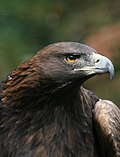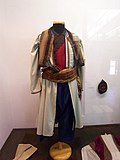National symbols of Montenegro are the symbols that are used in Montenegro to represent what is unique about the nation, reflecting different aspects of its cultural life and history.[1]
Symbols of Montenegro[edit]
| Type | Image | Symbol | |
|---|---|---|---|
| National flag | 
|
Flag of Montenegro The flag of Montenegro is red, with the coat of arms in the middle, and golden borders. The ratio of the flag is 1:2. The coat of arms takes up 2/3 of the flag's height. The middle point of the coat of arms matches the middle point of the flag. The width of the border is 1/20 of the flag's proportions. Two versions of the Montenegrin flag are in use, horizontal, mostly used outdoor; and vertical, mostly used indoor. | |
| Coat of arms | 
|
Coat of arms of Montenegro The charge is a two-headed eagle which is a symbol of Byzantine and ultimately Roman origin. It symbolises dual authority, such as that over the church and state. The motif was used by medieval rulers of Zeta—the House of Crnojević, as well as various other European dynasties. The layout of the Montenegrin coat of arms is inspired by that of the Russian Empire, with which the ruling House of Petrović-Njegoš had close dynastic and political ties in the 19th century when the coat of arms was first adopted in its present form. | |
| National anthem | Oj, svijetla majska zoro "Oj, svijetla majska zoro" (Montenegrin Cyrillic: „Ој, свијетла мајска зоро”, trans. "Oh, Bright Dawn of May") is the official national anthem of Montenegro adopted in 2004. Before becoming the anthem, it was a popular folk song of the Montenegrins, with many variations of its text. The oldest one is dated to the 2nd half of the 19th century, known as "Oh, Bright Dawn of Heroism, oh!", a popular Montenegrin folk song. | ||
| National animal | 
|
Golden eagle (Aquila chrysaetos) | |
| National tree | 
|
Mirovica olive tree | |
| National flower | 
|
Mimoza | |
| National mount | 
|
Mount Lovćen | |
| National dress | 
|
Montenegrin costume | |
| National instrument | 
|
Gusle | |
| National dance | Montenegrin Oro | ||
| National drink | 
|
Rakija | |
| National colours | Red and gold | Red Gold |
References[edit]
- ^ "National symbols of Montenegro". 28 December 2020. Retrieved 2023-02-09.

Well, that’s interesting to know that Psilotum nudum are known as whisk ferns. Psilotum nudum is the commoner species of the two. While the P. flaccidum is a rare species and is found in the tropical islands. Both the species are usually epiphytic in habit and grow upon tree ferns. These species may also be terrestrial and grow in humus or in the crevices of the rocks.
View the detailed Guide of Psilotum nudum: Detailed Study Of Psilotum Nudum (Whisk Fern), Classification, Anatomy, Reproduction